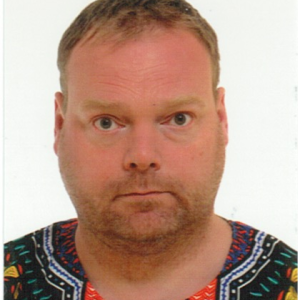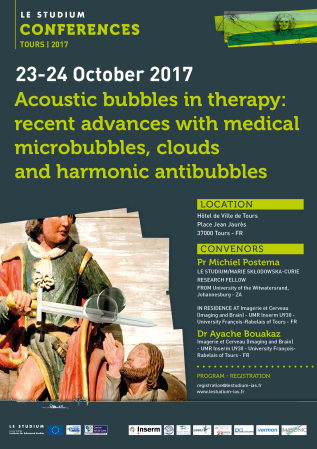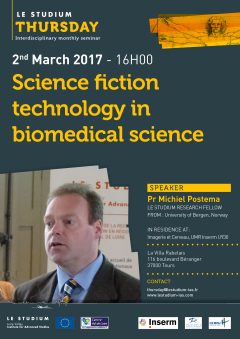Prof. Michiel Postema

Établissement d'origine
Laboratoire d'accueil
Imagerie et Cerveau (IC), INSERM / Université de Tours - FR
Hôte scientifique
PROJET
Anti-bulles acoustiques en imagerie harmonique et thérapie
Certains liquides peuvent contenir des anti-bulles. Une anti-bulle se compose d'une gouttelette de noyau liquide encapsulé par une bulle de gaz. Les agents tensio-actifs sur les deux interfaces liquide-gaz de l'anti-bulle sont chargés électriquement, empêchant ainsi le noyau de la gouttelette d’être en contact direct avec la surface extérieure des bulles. Les anti-bulles ont été observées dans divers produits laitiers, la bière belge, et des agents de contraste ultrasonore.
Comme pour les bulles régulières et les agents de contraste pour ultrasons, les anti-bulles oscillent suite à l’application d’ondes ultrasonores. Dans le cas de l’anti-bulle et en raison de son caractère incompressible, son expansion est plus importante que sa compression. Cette asymétrie de l’oscillation de l’anti-bulle engendre la génération d’harmoniques supérieures. Pour cette raison, l’anti-bulle représente un système ultrasonore non linéaire idéal pour l’imagerie ultrasonore harmonique. Dans des études précédentes réalisées par le groupe d’acoustique Norvégien à l’université de Bergen, l’utilisation des anti-bulles comme agent de contraste a été explorée et un modèle théorique a été proposé. De plus, il a été suggéré de transporter des substances thérapeutiques dans le coeur de l’anti-bulle pour une délivrance locale et précise.
Néanmoins, afin de pouvoir exploiter les anti-bulles comme agent d’imagerie et de thérapie, il est nécessaire de prédire l’interaction des anti-bulles avec les ultrasons. Le projet proposé ici a pour objectif d’apporter des compétences complémentaires pour développer un modèle mathématique de la dynamique des anti-bulles prenant en compte les propriétés viscoélastiques de la paroi. De plus, une étude expérimentale sera mise en place afin d’étudier les réponses harmoniques des anti-bulles en utilisant des sondes multi-fréquentielles.
Publications
This paper analyses the influence of the transducer bandwidth on the compression and the axial resolution of an ultrasound image. The distortion of an electrical signal visible in the final image is a major problem in ultrasonography. To solve this problem, the bit length in Golay-complementary sequences was elongated, narrowing the fractional bandwidth of the coded sequences. Therefore, more energy of the burst signal could be transferred through the ultrasound transducer. The experimental results obtained for transmission of the complementary Golay-coded sequences with two different bit lengths – one-cycle and two-cycles – have been compared, and the efficiency of the pulse compression and its influence on the axial resolution for two fractional bandwidths have been discussed. The results are presented for two transducers having a fractional bandwidth of 25% and 80% and operating at a 6-MHz frequency. The results obtained show that the elongation of the Golay single bit length (doubled in our case) compensate for the limited transducer bandwidth. 2D ultrasound images of a tissue-mimicking phantom are presented and demonstrate the benefits of the use of two-cycle bit length.
The ability to exclude harmful factors from a hydrogel microbead is important for the degree of protection the beads offers to what is encapsulated within. The permeability of alginate microbeads, prepared by water-in-oil emulsification, was investigated by their ability to exclude FITC-labelled protein probes. The influence of alginate concentration, calcium concentration and method of addition, and salt content of the environment was investigated. The permeability was also compared to the permeability of beads made by the traditional method of dripping an alginate solution into a CaCl2 solution. Beads produced with low amounts of CaCl2 show a significant degree of swelling and are therefore very permeable (C/C0 (BSA) = 0.62, where C is the final concentration of BSA-FITC in the bead, and C0 the concentration of BSA-FITC in the continuous phase). With additional calcium, either by adding more calcium crystals after the emulsification step or by washing with a CaCl2 solution, beads swell less and are less permeable (C/C0 (BSA) = 0.13 and 0.12). Beads made by dripping are very permeable (C/C0 (BSA) ∼ 0.60). Because in this process the droplets of alginate are not constrained by a water-oil boundary, the beads can swell during gelation. The salt concentration in the continuous phase influences the strength of the electrostatic repulsion between the probes and the alginate network and hence affects the permeation of the probes into the beads. In the absence of salt, even FITC (389Da) is mostly excluded from the interior of the beads (C/C0 (FITC) ∼ 0.09).
An antibubble is a gas bubble containing a liquid droplet core. Both the droplet and the gas bubble are typically surrounded by stabilising shells. Owing to electrostatic forces exerted by these shells, core droplets of micrometer diameter do not readily coalesce with the surrounding liquid medium. Owing to the incompressibility of the liquid droplet core, antibubbles will oscillate asymmetrically, i.e., the radial excursion amplitude of the surface is greater during expansion than during contraction, when subjected to diagnostic ultrasound. Consequently, the harmonic content of the ultrasound signal radiated from antibubbles must be higher than that from identical bubbles without a liquid core. Whether the harmonic signal component generated by physical antibubbles is higher than the harmonic component of identical bubbles without a core has been studied here. We subjected prefabricated antibubbles and identical bubbles without core droplets to 1-MHz ultrasound and to a commercial ultrasound system, and recorded the spectra with a broadband transducer oriented perpendicularly to the transmitter. Normalised by the acoustic response from the medium, the antibubble signal shows stronger higher harmonics than the reference signal, and negligible fundamental response. In conclusion, antibubbles are suitable candidates for harmonic imaging. The generation of higher harmonics without fundamental has been attributed to asymmetric antibubble expansion.
Microbubble-based ultrasound contrast agents are used in clinical settings to enhance backscattered ultrasound signals from blood during perfusion and blood flow measurements. The dynamics of microbubbles contained in ultrasound contrast agents are typically studied with a high-speed camera attached to a microscope. Such microbubbles, with resting diameters between 1 µm and 7 µm, are considered in optical focus if the bubble centers are in the focal plane of the objective lens. Nonetheless, when a three-dimensional object, a stack of infinitely thin two-dimensional layers, is imaged through a microscope, the image formed onto the charge coupled device element consists of contributions from all layers. If a bubble is larger than the depth of focus, the part of the bubble above the focal plane influences the image formation and therefore the bubble size measured. If a bubble is of a size in the order of the wavelengths of the light used, the system resolution and the segmentation method influence the bubble size measured. In this study, the projections of three dimensional microbubbles (hollow spheres) were computed with an ideal, weighted three-dimensional point spread function to find out under which circumstances the optical image formation leads to a significant deviation in measurement of the actual size. The artificial images were subjected to segmentation techniques for objectively comparing original microbubble sizes with measured microbubble sizes. Results showed that a systematic error was observed for objects in focus with radius ≤ 1.65µm. Also it was concluded that even though a three-dimensional object is in focus, there is discrepancy of up to 0.66% in size measurement. In addition, size measurement of an object for the same shift above and below focus could differ by up to 3.6%. Moreover, defocusing above 25% severely deviates size measurements while defocusing up to 90% could result in mean percentage error of up to 67.96.
The recycling of lithium ion batteries has been mentioned as one of the near-future waste management necessities. In order for recycling to be economically viable, straightforward and cost effective techniques need to be developed to separate the individual materials in a composite electrode. Ultrasonic separation might be such a technique, provided that lithium ion battery microparticles respond predictably to a sound field. Lithium ion battery cathodes contain hydrophobic carbon. Owing to the incompressibility of a solid, the thin gaseous layer surrounding these hydrophobic particles must oscillate asymmetrically, when subjected to ultrasound. Consequently, the harmonic content of the ultrasound signal radiated from hydrophobic microparticles must be higher than that from hydrophilic microparticles with the same size. The question of whether the harmonic signal response generated by physical hydrophobic microparticles present in lithium ion battery cathodes is higher than the harmonic response of other component materials in the cathode is the focus of this paper. The scattering response of cathode materials subjected to 1-MHz ultrasound was measured and compared. The cathode materials C65, PVDF, and NMC respond differently to 1-MHz ultrasound. The superharmonic response of C65 has been attributed to asymmetric oscillations owing to its hydrophobicity. In addition, C65 hydrophobic microparticles might be suitable candidates for harmonic imaging.


